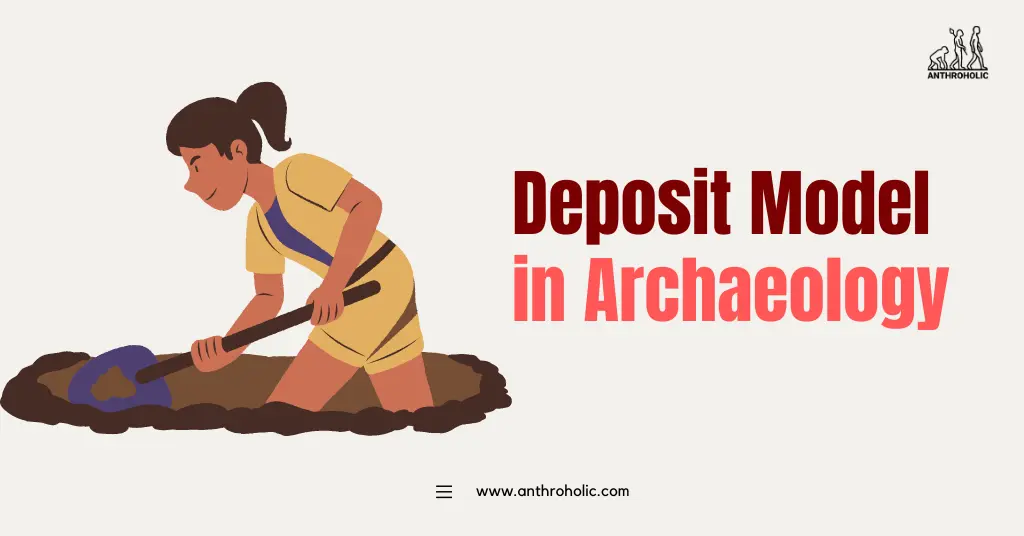AI Answer Evaluation Platform Live Now. Try Free Answer Evaluation Now
Archaeological Deposit Model
The Archaeological Deposit Model (ADM) provides a vital tool for interpreting buried archaeological remains. Derived from geological stratigraphy, it is employed to understand the chronological sequence of site formation [1]. It is composed of various elements such as artifacts, features, and ecofacts laid down through human activities, natural processes, or a combination of both.

Components of an ADM
Understanding an ADM necessitates grasping its primary components, which include:
- Artifacts: These are human-made or modified movable objects.
- Ecofacts: Natural remains that bear signs of human activity but are not intentionally modified.
- Features: Non-movable artifacts such as hearths or postholes.
- Structures: Built elements, like buildings or defensive works.
- Cultural deposits: These are layers or patches containing artifacts, ecofacts, or features.
- Natural deposits: Layers or strata resulting from environmental processes [2].
Building a Deposit Model
Building a deposit model involves a four-stage process:
- Stratigraphic Analysis: The first stage involves the creation of a site’s stratigraphic sequence, with each stratum (layer) identified and recorded for its characteristics, contents, and relationship to other strata.
- Phase Definition: After the stratigraphic sequence has been established, related strata are grouped into phases, each representing a specific period or event in the site’s history.
- Interpretation: The collected data are interpreted based on their chronological and cultural contexts, including the activities, behaviors, or events they represent.
- Synthesis: The final stage involves combining all the interpreted data to create a comprehensive, coherent story about the site’s past [3].
Table 1. Example of a Stratigraphic Sequence
| Stratum | Description | Contents |
|---|---|---|
| Stratum 1 | Topsoil | Modern debris |
| Stratum 2 | Dark brown, organic-rich layer | Medieval pottery, animal bones |
| Stratum 3 | Yellow-brown sandy layer | Roman artifacts, charcoal |
| Stratum 4 | Natural subsoil | No finds |
Case Study: The Must Farm Bronze Age Site
The Must Farm site in the UK provides an excellent example of how an ADM can reveal a detailed narrative about a site’s history. The site had multiple layers of waterlogged deposits containing well-preserved Bronze Age structures, artifacts, and ecofacts [4].
The stratigraphic analysis identified several phases of human activity separated by periods of natural deposition. The ADM also revealed how the settlement was destroyed by a catastrophic fire, after which it fell into a river and was preserved in situ. This extraordinary level of preservation allowed archaeologists to reconstruct daily life during the Bronze Age in unprecedented detail.
The Importance of ADM in Archaeology
ADM is critical to archaeology for several reasons:
- It allows archaeologists to reconstruct the chronological sequence of site formation.
- It aids in identifying different phases of human activity and natural events.
- It provides a context for understanding the relationship between artifacts, features, and ecofacts.
- It helps in interpreting past human behaviors, activities, and events.
Challenges in Developing an ADM
Despite its usefulness, constructing an ADM is not without challenges:
- Preservation Bias: Not all materials survive equally well in the archaeological record. Organic materials, for example, decay unless preserved in specific conditions. This differential preservation can skew our understanding of the past.
- Taphonomy: This involves the study of processes affecting materials after their deposition, such as erosion, bioturbation, and post-depositional movement. These processes can obscure the original context and sequence of deposition.
- Sampling Bias: Archaeologists can’t excavate every part of a site, and the areas chosen for excavation may not be representative of the site as a whole.
Applying Technology to ADM
To overcome these challenges, archaeologists are turning to technology:
- 3D modelling tools allow for accurate documentation and visualization of complex stratigraphic sequences, enabling archaeologists to analyze site formation processes in greater detail.
- Geochemical and micromorphological analyses can reveal microscopic traces of past activities, providing additional information about the formation and use of archaeological deposits.
- Radiocarbon dating and other scientific dating techniques can provide precise dates for archaeological deposits, allowing for the creation of more accurate ADMs.
Conclusion
ADM is a powerful tool that allows archaeologists to reconstruct the past from the remains left in the archaeological record. As technology advances, the potential for more precise and detailed ADMs continues to grow, promising exciting developments in our understanding of human history.
References
[1] Harris, E. C. (1989). Principles of Archaeological Stratigraphy. 2nd Edition. Academic Press.
[2] Roskams, S. (2001). Excavation. Cambridge Manuals in Archaeology. Cambridge University Press.
[3] Carver, M. (2009). Archaeological Investigation. Routledge.
[4] Knight, M. et al. (2016). “The Must Farm pile-dwelling settlement”. Antiquity, 90(351), pp. 695-710.




